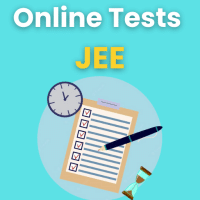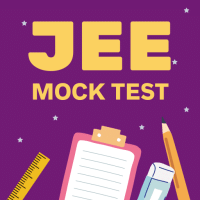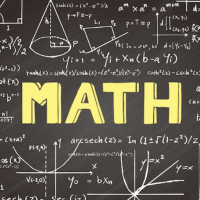JEE Exam > JEE Questions > An objective type test paper has 5 questions....
Start Learning for Free
An objective type test paper has 5 questions. Out of these 5 questions, 3 questions have four options each (A, B, C, D) with one option being the correct answer. The other 2 questions have two options each, namely True and False. A candidate randomly ticks the options. Then the probability that he/she will tick the correct option in at least four questions, is
- a)5/32
- b)3/128
- c)3/256
- d)3/64
Correct answer is option 'D'. Can you explain this answer?
Verified Answer
An objective type test paper has 5 questions. Out of these 5 questions...
n(S) = 43. 22, n(e) = (3C1 .3 + 2C1. 1) + 1
Most Upvoted Answer
An objective type test paper has 5 questions. Out of these 5 questions...
Objective Type Test Paper
Objective type test papers often consist of multiple-choice questions with various options. In this particular scenario, we have a test paper with 5 questions. Let's break down the question and calculate the probability of ticking the correct option in at least four questions.
Question Breakdown:
Out of the 5 questions:
- 3 questions have four options each (A, B, C, D), with one correct option.
- 2 questions have two options each, namely True and False.
Calculating the Probability:
To calculate the probability of ticking the correct option in at least four questions, we need to consider the different combinations in which this can occur.
Case 1: Ticking all three questions with four options correctly
In this case, the probability of ticking all three questions correctly is (1/4) * (1/4) * (1/4) = 1/64.
Case 2: Ticking two questions with four options correctly and one True/False question correctly
There are three ways to choose the two questions with four options and one question with True/False. The probability for each combination is:
- (1/4) * (1/4) * (1/2) = 1/32 (for two four-option questions and one True/False question)
- (1/4) * (1/4) * (1/2) = 1/32 (for two four-option questions and one True/False question)
- (1/4) * (1/4) * (1/2) = 1/32 (for two four-option questions and one True/False question)
So, the total probability for this case is 1/32 + 1/32 + 1/32 = 3/32.
Case 3: Ticking one question with four options correctly and both True/False questions correctly
There are three ways to choose the one question with four options and two questions with True/False. The probability for each combination is:
- (1/4) * (1/2) * (1/2) = 1/16 (for one four-option question and two True/False questions)
- (1/4) * (1/2) * (1/2) = 1/16 (for one four-option question and two True/False questions)
- (1/4) * (1/2) * (1/2) = 1/16 (for one four-option question and two True/False questions)
So, the total probability for this case is 1/16 + 1/16 + 1/16 = 3/16.
Case 4: Ticking all three True/False questions correctly
The probability of ticking all three True/False questions correctly is (1/2) * (1/2) * (1/2) = 1/8.
Calculating the Total Probability:
To calculate the total probability of ticking the correct option in at least four questions, we add up the probabilities from all the cases:
1/64 + 3/32 + 3/16 + 1/8 = 1/64 + 6/64 + 12/64 +
Objective type test papers often consist of multiple-choice questions with various options. In this particular scenario, we have a test paper with 5 questions. Let's break down the question and calculate the probability of ticking the correct option in at least four questions.
Question Breakdown:
Out of the 5 questions:
- 3 questions have four options each (A, B, C, D), with one correct option.
- 2 questions have two options each, namely True and False.
Calculating the Probability:
To calculate the probability of ticking the correct option in at least four questions, we need to consider the different combinations in which this can occur.
Case 1: Ticking all three questions with four options correctly
In this case, the probability of ticking all three questions correctly is (1/4) * (1/4) * (1/4) = 1/64.
Case 2: Ticking two questions with four options correctly and one True/False question correctly
There are three ways to choose the two questions with four options and one question with True/False. The probability for each combination is:
- (1/4) * (1/4) * (1/2) = 1/32 (for two four-option questions and one True/False question)
- (1/4) * (1/4) * (1/2) = 1/32 (for two four-option questions and one True/False question)
- (1/4) * (1/4) * (1/2) = 1/32 (for two four-option questions and one True/False question)
So, the total probability for this case is 1/32 + 1/32 + 1/32 = 3/32.
Case 3: Ticking one question with four options correctly and both True/False questions correctly
There are three ways to choose the one question with four options and two questions with True/False. The probability for each combination is:
- (1/4) * (1/2) * (1/2) = 1/16 (for one four-option question and two True/False questions)
- (1/4) * (1/2) * (1/2) = 1/16 (for one four-option question and two True/False questions)
- (1/4) * (1/2) * (1/2) = 1/16 (for one four-option question and two True/False questions)
So, the total probability for this case is 1/16 + 1/16 + 1/16 = 3/16.
Case 4: Ticking all three True/False questions correctly
The probability of ticking all three True/False questions correctly is (1/2) * (1/2) * (1/2) = 1/8.
Calculating the Total Probability:
To calculate the total probability of ticking the correct option in at least four questions, we add up the probabilities from all the cases:
1/64 + 3/32 + 3/16 + 1/8 = 1/64 + 6/64 + 12/64 +

|
Explore Courses for JEE exam
|

|
Question Description
An objective type test paper has 5 questions. Out of these 5 questions, 3 questions have four options each (A, B, C, D) with one option being the correct answer. The other 2 questions have two options each, namely True and False. A candidate randomly ticks the options. Then the probability that he/she will tick the correct option in at least four questions, isa)5/32b)3/128c)3/256d)3/64Correct answer is option 'D'. Can you explain this answer? for JEE 2025 is part of JEE preparation. The Question and answers have been prepared according to the JEE exam syllabus. Information about An objective type test paper has 5 questions. Out of these 5 questions, 3 questions have four options each (A, B, C, D) with one option being the correct answer. The other 2 questions have two options each, namely True and False. A candidate randomly ticks the options. Then the probability that he/she will tick the correct option in at least four questions, isa)5/32b)3/128c)3/256d)3/64Correct answer is option 'D'. Can you explain this answer? covers all topics & solutions for JEE 2025 Exam. Find important definitions, questions, meanings, examples, exercises and tests below for An objective type test paper has 5 questions. Out of these 5 questions, 3 questions have four options each (A, B, C, D) with one option being the correct answer. The other 2 questions have two options each, namely True and False. A candidate randomly ticks the options. Then the probability that he/she will tick the correct option in at least four questions, isa)5/32b)3/128c)3/256d)3/64Correct answer is option 'D'. Can you explain this answer?.
An objective type test paper has 5 questions. Out of these 5 questions, 3 questions have four options each (A, B, C, D) with one option being the correct answer. The other 2 questions have two options each, namely True and False. A candidate randomly ticks the options. Then the probability that he/she will tick the correct option in at least four questions, isa)5/32b)3/128c)3/256d)3/64Correct answer is option 'D'. Can you explain this answer? for JEE 2025 is part of JEE preparation. The Question and answers have been prepared according to the JEE exam syllabus. Information about An objective type test paper has 5 questions. Out of these 5 questions, 3 questions have four options each (A, B, C, D) with one option being the correct answer. The other 2 questions have two options each, namely True and False. A candidate randomly ticks the options. Then the probability that he/she will tick the correct option in at least four questions, isa)5/32b)3/128c)3/256d)3/64Correct answer is option 'D'. Can you explain this answer? covers all topics & solutions for JEE 2025 Exam. Find important definitions, questions, meanings, examples, exercises and tests below for An objective type test paper has 5 questions. Out of these 5 questions, 3 questions have four options each (A, B, C, D) with one option being the correct answer. The other 2 questions have two options each, namely True and False. A candidate randomly ticks the options. Then the probability that he/she will tick the correct option in at least four questions, isa)5/32b)3/128c)3/256d)3/64Correct answer is option 'D'. Can you explain this answer?.
Solutions for An objective type test paper has 5 questions. Out of these 5 questions, 3 questions have four options each (A, B, C, D) with one option being the correct answer. The other 2 questions have two options each, namely True and False. A candidate randomly ticks the options. Then the probability that he/she will tick the correct option in at least four questions, isa)5/32b)3/128c)3/256d)3/64Correct answer is option 'D'. Can you explain this answer? in English & in Hindi are available as part of our courses for JEE.
Download more important topics, notes, lectures and mock test series for JEE Exam by signing up for free.
Here you can find the meaning of An objective type test paper has 5 questions. Out of these 5 questions, 3 questions have four options each (A, B, C, D) with one option being the correct answer. The other 2 questions have two options each, namely True and False. A candidate randomly ticks the options. Then the probability that he/she will tick the correct option in at least four questions, isa)5/32b)3/128c)3/256d)3/64Correct answer is option 'D'. Can you explain this answer? defined & explained in the simplest way possible. Besides giving the explanation of
An objective type test paper has 5 questions. Out of these 5 questions, 3 questions have four options each (A, B, C, D) with one option being the correct answer. The other 2 questions have two options each, namely True and False. A candidate randomly ticks the options. Then the probability that he/she will tick the correct option in at least four questions, isa)5/32b)3/128c)3/256d)3/64Correct answer is option 'D'. Can you explain this answer?, a detailed solution for An objective type test paper has 5 questions. Out of these 5 questions, 3 questions have four options each (A, B, C, D) with one option being the correct answer. The other 2 questions have two options each, namely True and False. A candidate randomly ticks the options. Then the probability that he/she will tick the correct option in at least four questions, isa)5/32b)3/128c)3/256d)3/64Correct answer is option 'D'. Can you explain this answer? has been provided alongside types of An objective type test paper has 5 questions. Out of these 5 questions, 3 questions have four options each (A, B, C, D) with one option being the correct answer. The other 2 questions have two options each, namely True and False. A candidate randomly ticks the options. Then the probability that he/she will tick the correct option in at least four questions, isa)5/32b)3/128c)3/256d)3/64Correct answer is option 'D'. Can you explain this answer? theory, EduRev gives you an
ample number of questions to practice An objective type test paper has 5 questions. Out of these 5 questions, 3 questions have four options each (A, B, C, D) with one option being the correct answer. The other 2 questions have two options each, namely True and False. A candidate randomly ticks the options. Then the probability that he/she will tick the correct option in at least four questions, isa)5/32b)3/128c)3/256d)3/64Correct answer is option 'D'. Can you explain this answer? tests, examples and also practice JEE tests.

|
Explore Courses for JEE exam
|

|
Signup for Free!
Signup to see your scores go up within 7 days! Learn & Practice with 1000+ FREE Notes, Videos & Tests.


















